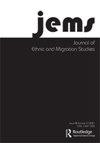局外人内部:通过流散的镜头审视埃塞俄比亚被收养者的经历
IF 2.8
1区 社会学
Q1 DEMOGRAPHY
引用次数: 0
摘要
随着公众和学术界努力应对一个日益以人员、思想和资本的跨国流动为特征的世界,“侨民”一词继续具有重要意义。这个概念在使这些混乱的社会、政治和经济联系清晰可见方面发挥了关键作用。然而,跨国被收养者往往被置于这一分析范围之外,他们的迁移、身份认同过程和政治项目很少通过“散居”概念镜头来审视。基于对居住在美国的成年埃塞俄比亚被收养者的20次深度访谈,本文讨论了埃塞俄比亚被收养者与更大的埃塞俄比亚侨民之间的脱节/联系。我们关注的是埃塞俄比亚被收养者如何在社会群体中作为边缘角色驾驭他们的包容/排斥,以及他们参与的积极工作,以协商他们的散居身份、财产和个人政治。这一分析使我们注意到流散社区边缘的新参与者,这使流散的主流概念变得复杂和丰富。关键词:归属、侨民、埃塞俄比亚身份、跨国收养披露声明作者未报告潜在的利益冲突。注1跨国被收养者至少有一位在世的亲生父母,这种情况并不罕见。联合国儿童基金会(Citation2014)将孤儿定义为父母一方去世的孩子,区分了母亲、父亲和双孤儿。此外,儿童可能被错误地归类为孤儿,从而欺诈性地为潜在的养父母创造持续的“可收养”儿童供应(Hailu Citation2017;斯丁洛特Citation2022)。为了说明这一点,被埃塞俄比亚/厄立特里亚收养的Hannah Pool (Citation2009)写了她如何在30多岁时发现她的父亲还健在。同样,仅在我们的样本中,20名被收养者中就有14名至少有一位在世的亲生父母,并与埃塞俄比亚的家人保持或重新建立了联系。2扎哈拉·马利·朱莉-皮特(2005年出生)是名人夫妇安吉丽娜·朱莉和布拉德·皮特的养女。扎哈拉出生在埃塞俄比亚的哈瓦萨,在6个月大的时候被收养,之前被称为YemeserachTsehay Hawkins(出生于2005年),出生于埃塞俄比亚的亚的斯亚贝巴,五个月大时被一对澳大利亚白人夫妇收养。她是一名演员、舞蹈家和歌手,最著名的是澳大利亚儿童音乐团体the wiggle的成员根据Peter Selman (Citation2022)的数据,2003年至2016年间,有3.2万名埃塞俄比亚儿童被全球北方的八个国家收养,分别是美国、加拿大、西班牙、意大利、丹麦、瑞士和比利时。这还不包括2003年之前和2016年至2018年之间的收养,当时埃塞俄比亚政府禁止这种做法。此外,其他重要的目的地,如瑞典,从埃塞俄比亚(20世纪60年代至70年代)收养的第一波,不包括在这个数字。如果我们扩大时间和地域限制,自埃塞俄比亚开始跨国收养实践以来,总数可能超过50,000。6该研究已获得[机构名称和IRB #编辑审查]的伦理许可收养三方由被收养人、亲生父母和养父母组成为了保护他们的身份,所有受访者的名字都改成了假名。除了他们的笔名外,我们还在括号中提供了受访者在采访时的性别和年龄Kassaye Berhanu-Mac Donald开设了自己的个人网站,记录了她作为被收养者的倡导、写作和反思,包括她自己和埃塞俄比亚社区多年来的经历。在这里阅读更多信息:https://www.kassayeberhanu.com/.10这个城市的名字被删去了任何可能识别这个被调查者的信息。本研究得到了北卡罗来纳大学格林斯博罗分校的支持。本文章由计算机程序翻译,如有差异,请以英文原文为准。
Outsiders within: examining Ethiopian adoptee experiences through a diasporic lens
ABSTRACTThe term ‘diaspora’ continues to have purchase, as public and scholarly communities grapple with a world increasingly characterized by transnational flows of people, ideas, and capital. The concept has played a critical role in making these messy constellations of social, political, and economic ties both visible and legible. However, transnational adoptees are often positioned just outside this analytical purview, and their migrations, identity processes, and political projects are rarely examined through a ‘diasporic’ conceptual lens. Based on 20 in-depth interviews with adult Ethiopian adoptees residing in the US, this paper discusses the points of dis/connection between Ethiopian adoptees and the larger Ethiopian diaspora. We focus on how Ethiopian adoptees navigate their inclusion/exclusion as peripheral actors across social groups, as well as the active work they engage in to negotiate their diasporic identities, belongings and personal politic. This analysis draws our attention to new actors at the edges of diasporic communities, which complicates and enriches mainstream conceptions of diaspora.KEYWORDS: BelongingdiasporaEthiopiaidentitytransnational adoption Disclosure statementNo potential conflict of interest was reported by the author(s).Notes1 It is not uncommon that transnational adoptees have at least one living birth parent. UNICEF (Citation2014) defines an orphan as a child with one deceased parent, distinguishing between maternal, paternal, and double orphans. Moreover, children can be erroneously categorized as orphans to fraudulently create a constant supply of ‘adoptable’ children to prospective adoptive parents (Hailu Citation2017; Steenrod Citation2022). To illustrate, Hannah Pool (Citation2009), an Ethiopian/Eritrean adoptee, writes about how she discovered that her father is well and alive in her thirties. Similarly, in our sample alone, 14 out of the 20 adoptees have at least one living birth parent and have maintained or re-established contact with their families in Ethiopia.2 Zahara Marley Jolie-Pitt (b. 2005) is the adopted daughter of the celebrity couple Angelina Jolie and Brad Pitt. Zahara was born in Hawassa, Ethiopia and known as Yemeserach before being adopted at six month old.3 Tsehay Hawkins (b. 2005), was born in Addis Ababa, Ethiopia and adopted by a white Australia couple at five months old. She is an actor, dancer and singer, best known as a member of the Australia children's music group The Wiggles.4 See https://www.uscis.gov/adoption/country-information/adoption-information-ethiopia (last accessed 9/23/2023).5 According to Peter Selman (Citation2022) between 2003 and 2016, 32,000 Ethiopian children were adopted to eight Global North countries, namely the U.S. Canada, Spain, Italy, Denmark, Switzerland, and Belgium. This does not include adoptions that took place prior to 2003 and between 2016 and 2018, when the practice was banned by the Ethiopian government. Moreover, other significant destinations such as Sweden where the first wave of adoption from Ethiopia (1960s–1970s) took place, are not included in this number. If we expand the time period and geographic restriction, the overall number is likely to be over 50,000 since the practice of transnational adoption began in Ethiopia.6 The study has received ethical clearance from [Name of institution and IRB # redacted for review].7 An adoption triad is composed of adoptees, birth parents and adoptive parents.8 All the names of the respondents have been changed to pseudonyms to protect their identities. In addition to their pseudonyms, in parenthesis, we provide the gender and age of respondents at the time of the interview.9 Kassaye Berhanu-Mac Donald publishes her own personal website that chronicles her advocacy, writing and reflections related to her journey as an adoptee, including herness’ and Ethiopian communities over the years. Read more here: https://www.kassayeberhanu.com/.10 The name of this city was redacted to remove any potential information that could identify this respondent.Additional informationFundingThis work was supported by UNC Greensboro.
求助全文
通过发布文献求助,成功后即可免费获取论文全文。
去求助
来源期刊

Journal of Ethnic and Migration Studies
Multiple-
CiteScore
7.80
自引率
9.10%
发文量
157
期刊介绍:
The Journal of Ethnic and Migration Studies (JEMS) publishes the results of first-class research on all forms of migration and its consequences, together with articles on ethnic conflict, discrimination, racism, nationalism, citizenship and policies of integration. Contributions to the journal, which are all fully refereed, are especially welcome when they are the result of original empirical research that makes a clear contribution to the field of migration JEMS has a long-standing interest in informed policy debate and contributions are welcomed which seek to develop the implications of research for policy innovation, or which evaluate the results of previous initiatives. The journal is also interested in publishing the results of theoretical work.
 求助内容:
求助内容: 应助结果提醒方式:
应助结果提醒方式:


